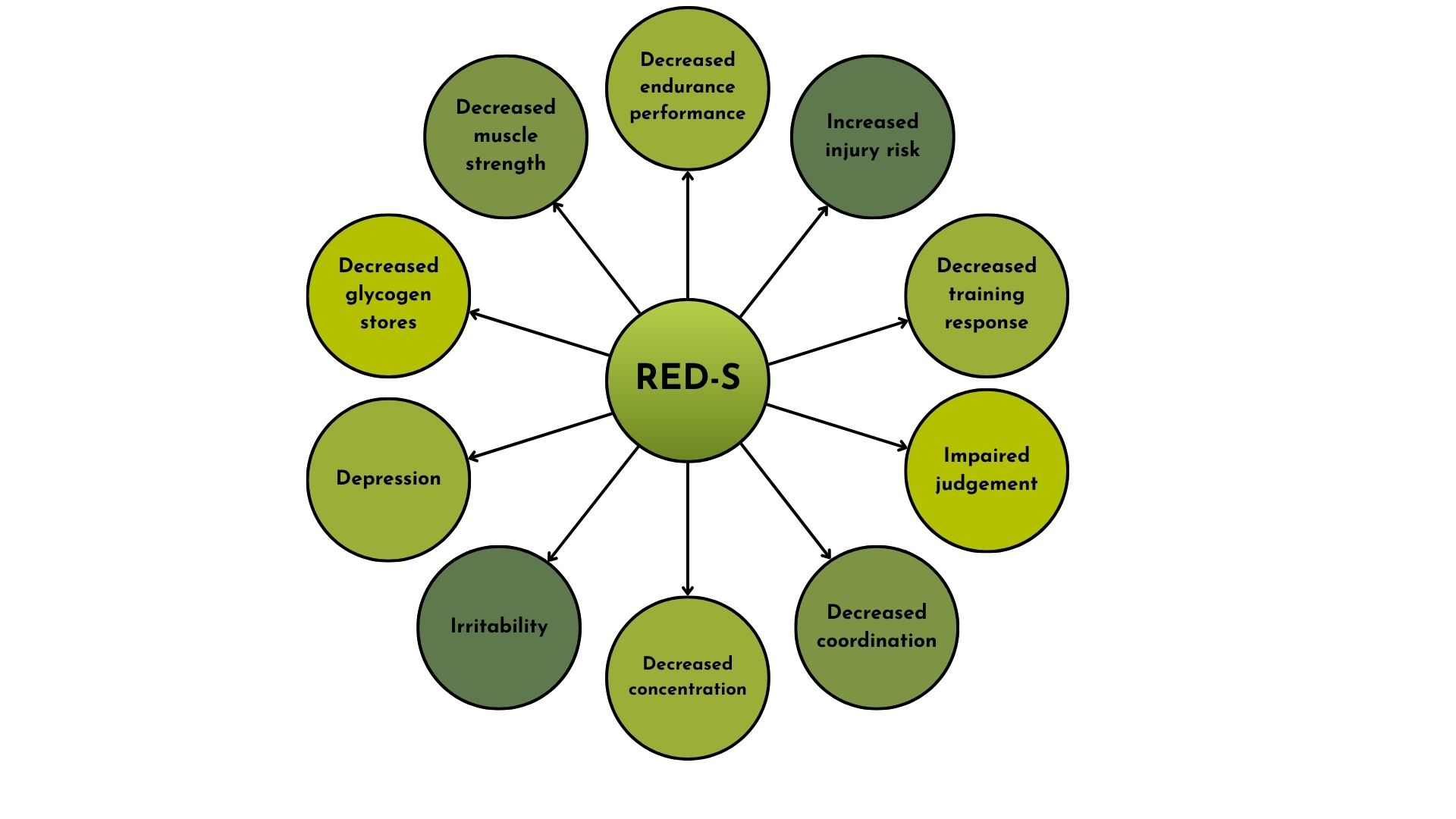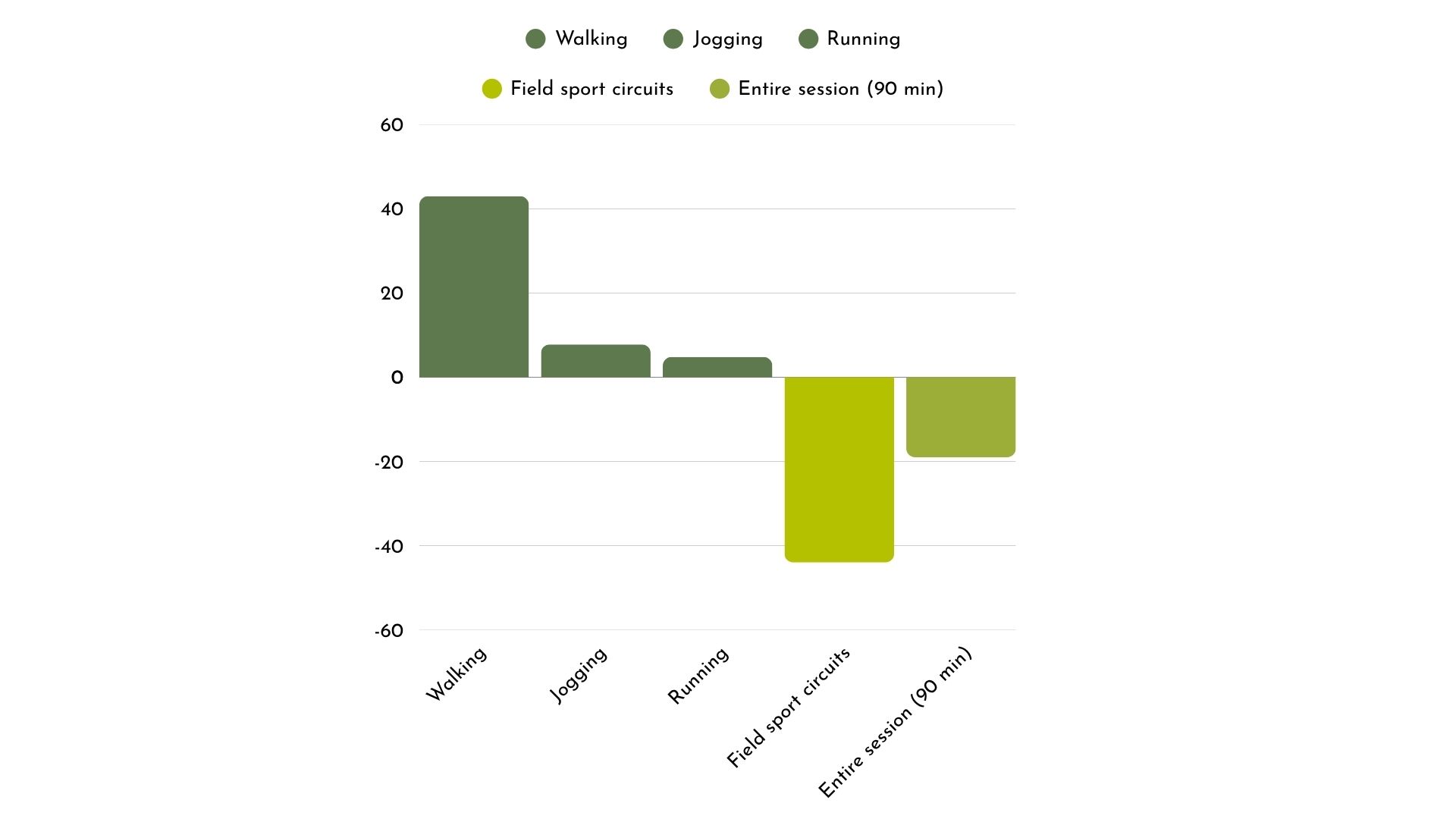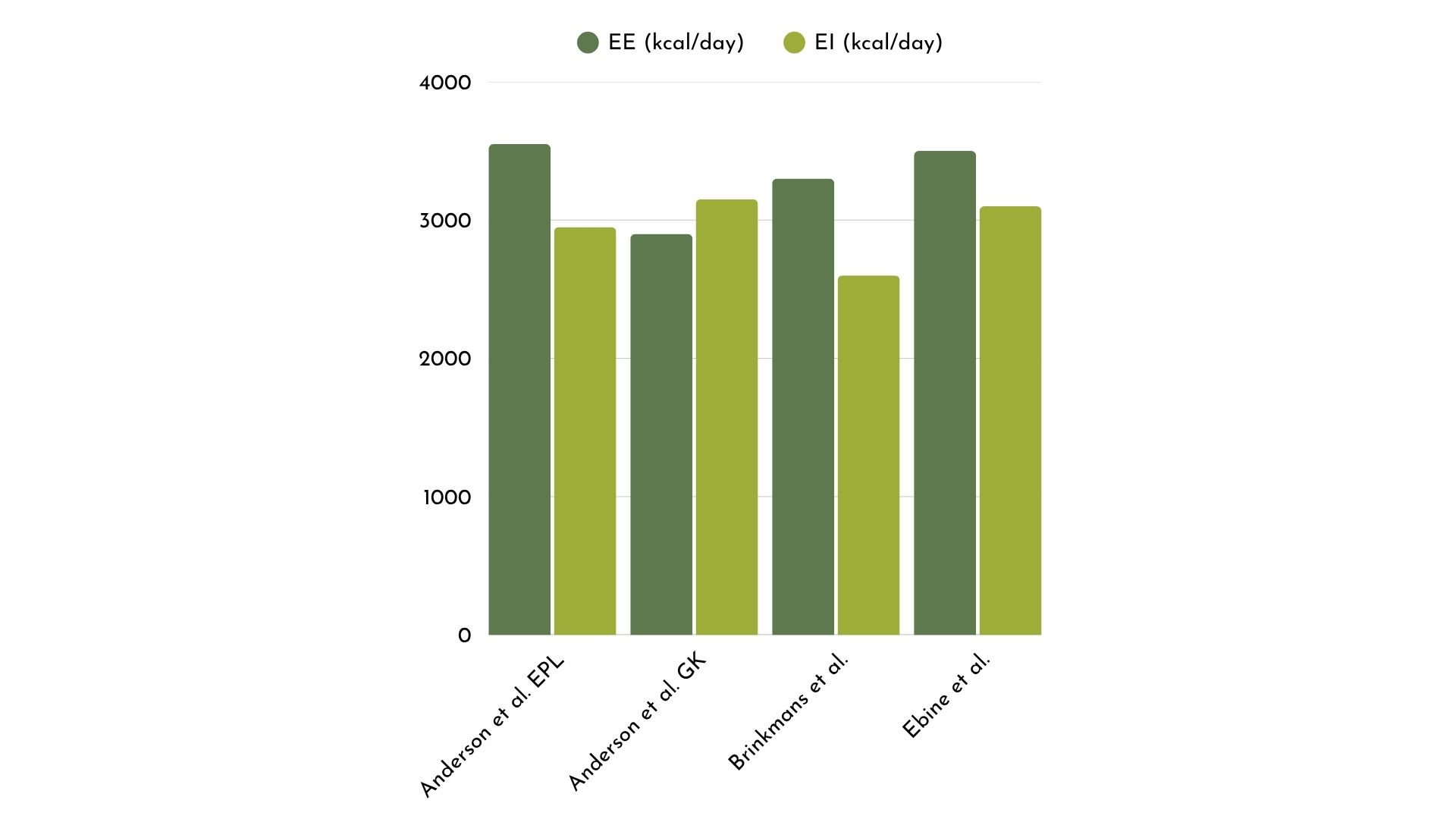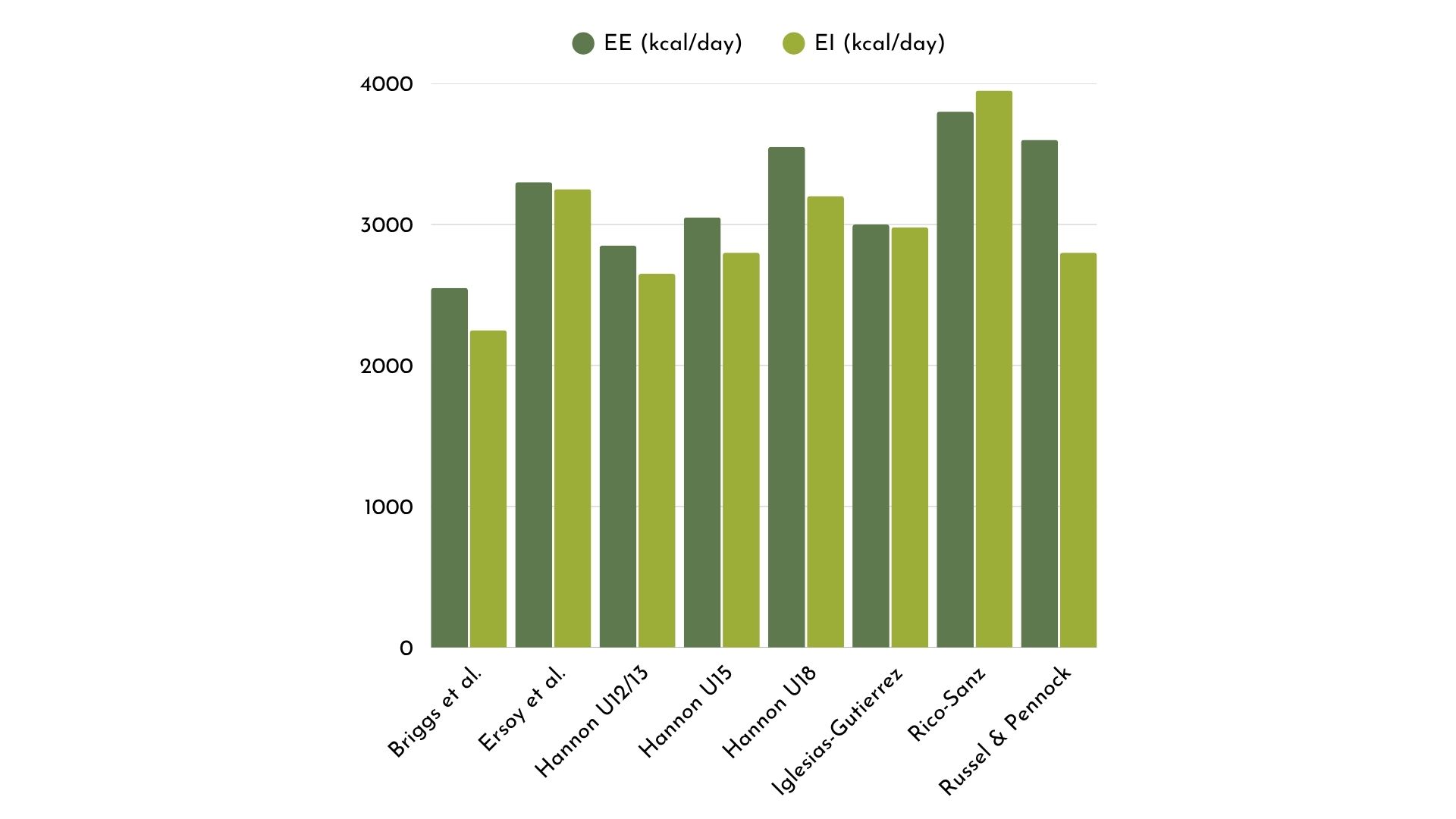Intro
When nutrition guidance is based on imprecise estimates of a player’s energy expenditure, the error is not just a number. It becomes the foundation for daily decisions on meals, portion sizes, and recovery.
A systematic deviation of several hundred kcal per day can, over the course of a week, add up to thousands of kcal, leading to flawed nutrition strategies. Over time, this may result in LEA (Low Energy Availability), increased risk of RED-S (Relative Energy Deficiency in Sport), impaired recovery, and underperformance.

Potential Performance Effects of Relative Energy Deficiency in Sport. Adapted from Mountjoy M, Sundgot-Borgen JK, Burke LM, et al.8
In this post, we review the evidence, mechanisms, and practical implications for dietitians and performance staff in football clubs — and show how smarter use of already collected data can help prevent these challenges.
Energy Availability (EA)
Even short periods of low energy availability can have significant physiological consequences. Studies have shown that just five days of LEA (~30 kcal·kg LBM-1·day-1) can:
-Reduce blood glucose levels
-Increase cortisol
-Suppress normal blood concentrations or pulsatility of metabolic hormones (e.g., insulin, IGF-1, leptin, triiodothyronine) and reproductive hormones (e.g., estradiol, GnRH, LH)
-Disrupt normal markers of bone turnover (e.g., reduced osteocalcin, increased urinary N-telopeptide)17
With chronic LEA, this can lead to oligomenorrhea or functional hypothalamic amenorrhea.19
In practice, this means:
- Signs of low energy availability: The body downregulates the reproductive system because there is not enough budget to maintain normal hormonal balance. It is a warning signal that the player is not meeting their energy needs.
- Increased injury risk: Especially stress fractures and overuse injuries, since estrogen plays a key role in bone turnover and bone strength.
- Reduced recovery and performance: Hormonal changes (low estrogen, low IGF-1, low T3, etc.) affect muscle repair, immune function, and energy metabolism.
- Long-term health: Persistent functional hypothalamic amenorrhea can reduce bone density (osteopenia/osteoporosis), increasing the risk of fractures later in life.
Based on these findings, a scale of healthy, subclinical, and low EA has been developed, which can be used for monitoring in practice.18
Background — why precision in estimates matters
Football is one of the most complex sports to measure energy expenditure in: accelerations, sprints, changes of direction, and duels create a metabolic load that standard methods rarely capture fully.
GPS-based models, certain wearables, and linear HR calibrations can deviate substantially from a player’s actual energy turnover — especially in high-intensity periods.4-7
When these estimates are used directly to set energy and carbohydrate targets, measurement errors become flawed nutrition plans. Estimation errors can therefore be a hidden precursor to RED-S, underperformance, and injuries.
Evidence: how often and how large are the errors?
- Field studies show that many professional players operate close to or below the critical threshold for energy availability (<30 kcal/kg FFM/day).1-3

Football players total daily energy expenditure vs energy intake by positions. Average shows a large (-22%) energy deficit across positions
- Validation studies document systematic bias in GPS/Metabolic Power and wearables: underestimation at high intensity and overestimation at low intensity. Deviations can amount to several hundred kcal per match/day.4-7

Studies show large errors between metabolic power energy expenditure estimates (GPS-EE) vs actual energy expenditure with errors peaking at 44% when predicting field sport circuits.
- When nutrition plans are consistently based on such flawed estimates, players risk either chronic energy deficit or unwanted surplus.

Plot showing senior football players total daily energy expenditure vs energy intake in different studies with clear trends of energy deficit low energy availability.

Plot showing youth football players total daily energy expenditure vs energy intake in different studies with clear trends of energy deficit low energy availability.
From estimation error to practical consequences
Estimation errors set off a cascade of practical and physiological consequences.
Systematic underestimation of energy expenditure:
-Nutrition plans set energy and carbohydrate targets too low, so players consistently underfuel.
-Over time, LEA drives hormonal disturbances, weakens immune function, lowers bone density, and increases injury or illness risk (RED-S).8-12
Systematic overestimation of energy expenditure:
-Nutrition plans allow excessive intake, raising the risk of weight gain, increased fat mass, and loss of explosiveness.
-Altered body composition may impair acceleration and high-intensity performance.13-15
Short-term effects:
-Too little carbohydrate before a match reduces repeated-sprint ability and technical precision in the final stages of the game.3,16
-Lack of fueling between training sessions slows recovery, increases DOMS, and builds cumulative fatigue.1,9
Underlying mechanisms
-Glycogen stores: essential for repeated sprint ability and technical sharpness. Even moderate deficits can cause large performance swings.3 16
-Energy availability (EA): constant small deficits can disrupt hormonal balance, immune function, and recovery.10 11 17 18
-Adaptation & recovery: energy deficits impair protein synthesis and increase the risk of overuse injuries.9 10
What can be done in practice?
Preventing RED-S and related problems does not necessarily require new measurements, but smarter use of already existing data.
Key focus areas:
-Energy availability (EA): track trends over time to detect imbalances early.
-Body composition and physical parameters: longitudinal monitoring can serve as risk markers.
-Nutrition data in practice: linking intake and needs can highlight players with critical mismatches.
CarboPlanner develops solutions that integrate and visualize data on EA, body composition, physical parameters, and daily nutrition in a single system.
With valid, football-specific machine learning models, estimates can come much closer to reality and give dietitians and performance staff a more solid foundation.
Conclusion
Errors in estimating energy expenditure are not a minor issue. They form the very foundation of nutrition guidance and performance optimization.
When estimates are inaccurate, the entire decision-making basis is weakened. This can acutely impair performance and recovery, and over time trigger RED-S and increase injury risk.
By using smarter models, leveraging already collected data, and working with buffers and individualization, the risk can be significantly reduced.
Want to see how you can optimize your data foundation for energy needs? Book a demo with CarboPlanner today and experience the difference between guesswork and data-driven nutrition planning.
References
1- Dasa, M. S., et al. (2023). Energy expenditure, dietary intake and energy availability in professional female footballers. BMJ Open Sport & Exercise Medicine, 9(3), e001648. https://doi.org/10.1136/bmjsem-2023-001648
2- Hulton, A. T., et al. (2022). Energy requirements and nutritional strategies for male soccer players: A review. Nutrients, 14(21), 4610. https://doi.org/10.3390/nu14214610
3- Williams, C. A., et al. (2015). Carbohydrate nutrition and team sport performance. Sports Medicine, 45(S1), 13–22. https://doi.org/10.1007/s40279-015-0399-3
4- Brown, D. M., et al. (2016). Metabolic power method: Underestimation of energy expenditure in field-sport movements. International Journal of Sports Physiology and Performance, 11(8), 1067–1073. https://doi.org/10.1123/ijspp.2015-0379
5- O’Driscoll, R., et al. (2020). How well do activity monitors estimate energy expenditure? A systematic review and meta-analysis of the validity of current technologies. British Journal of Sports Medicine, 54(6), 332–340. https://doi.org/10.1136/bjsports-2018-100493
6- Brochhagen, J., & Hoppe, M. W. (2025). Validity of the metabolic power model in intermittent running. Frontiers in Sports and Active Living, 7, 1502875. https://doi.org/10.3389/fspor.2025.1502875
7- Savoia, C., et al. (2020). Validation of an updated metabolic power approach in elite soccer players. International Journal of Environmental Research and Public Health, 17(18), 6821. https://doi.org/10.3390/ijerph17186821
8- Mountjoy, M., et al. (2018). International Olympic Committee (IOC) consensus statement on relative energy deficiency in sport (RED-S): 2018 update. British Journal of Sports Medicine, 52(11), 687–697. https://doi.org/10.1136/bjsports-2018-099193
9- Burke, L. M., et al. (2018). Pitfalls of conducting and interpreting estimates of energy availability in free-living athletes. International Journal of Sport Nutrition and Exercise Metabolism, 28(4), 350–363. https://doi.org/10.1123/ijsnem.2018-0142
10- Areta, J. L., Taylor, H. L., & Koehler, K. (2021). Low energy availability: History, definition and physiological effects. European Journal of Applied Physiology, 121(12), 2735–2750. https://doi.org/10.1007/s00421-021-04717-0
11- Lee, B. L., et al. (2022). Low energy availability (LEA) in male athletes: A review. Sports Medicine - Open, 8(1), 118. https://doi.org/10.1186/s40798-022-00492-3
12- Greenwood, J. J., et al. (2023). Relative energy deficiency indicators in male adolescent endurance athletes: A longitudinal study. Nutrients, 15(5), 1085. https://doi.org/10.3390/nu15051085
13- Levine, J. A., et al. (2014). Effects of overfeeding on body composition and metabolism. The American Journal of Clinical Nutrition, 100(2), 539–546. https://doi.org/10.3945/ajcn.113.081778
14- Westerterp, K. R. (2004). Metabolic consequences of overfeeding in humans. International Journal of Obesity, 28(S4), S58–S61. https://doi.org/10.1038/sj.ijo.0802859
15- Hron, B. M., et al. (2015). Effect of protein overfeeding on energy expenditure measured in a metabolic chamber. The Journal of Clinical Endocrinology & Metabolism, 100(11), 4489–4497. https://doi.org/10.1210/jc.2015-2235
16- Jeukendrup, A. E., et al. (2019). Extra time and carbohydrate strategies in football: Implications for performance. Gatorade Sports Science Institute: Sports Science Exchange, 32(199), 1–6.
17- Ihle R, Loucks AB. Dose-response relationships between energy availability and bone turnover in young exercising women. J Bone Miner Res. 2004 Aug;19(8):1231-40. doi: 10.1359/JBMR.040410. Epub 2004 Apr 19. PMID: 15231009.
18- Loucks AB, Kiens B, Wright HH. Energy availability in athletes. J Sports Sci. 2011;29 Suppl 1:S7-15. doi: 10.1080/02640414.2011.588958. Epub 2011 Jul 28. PMID: 21793767.
19- Cabre, H. E., Moore, S. R., Smith-Ryan, A. E., & Hackney, A. C. (2022). Relative Energy Deficiency in Sport (RED-S): Scientific, Clinical, and Practical Implications for the Female Athlete. Deutsche Zeitschrift fur Sportmedizin, 73(7), 225–234. https://doi.org/10.5960/dzsm.2022.546
20- CarboPlanner. (2025). Precision in Energy Expenditure Estimates: Why Accuracy Matters in Football. CarboPlanner Blog.


